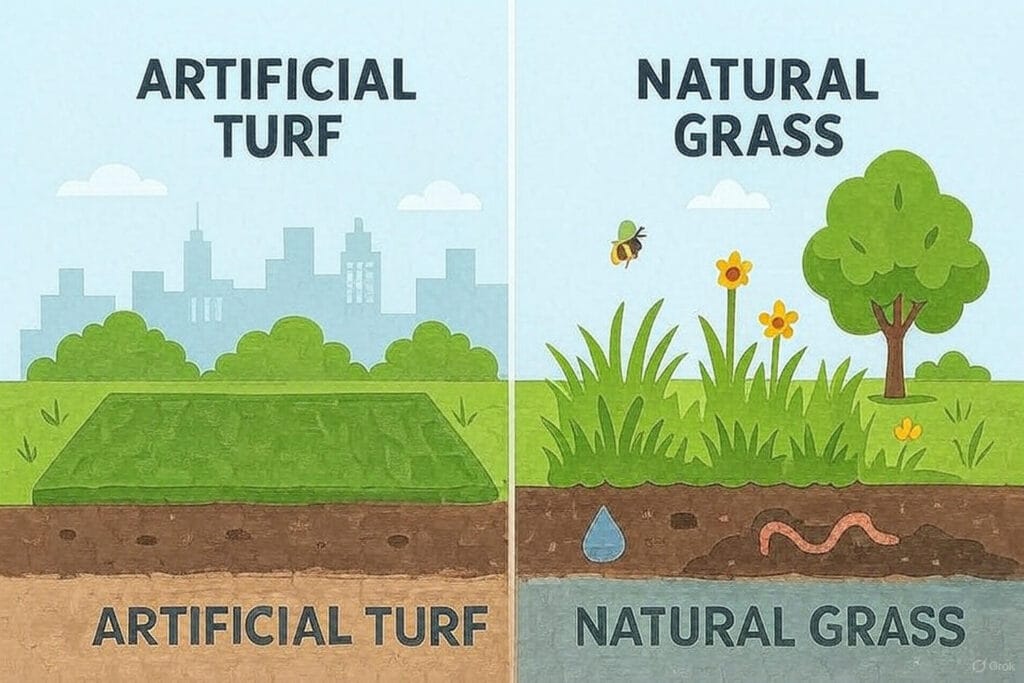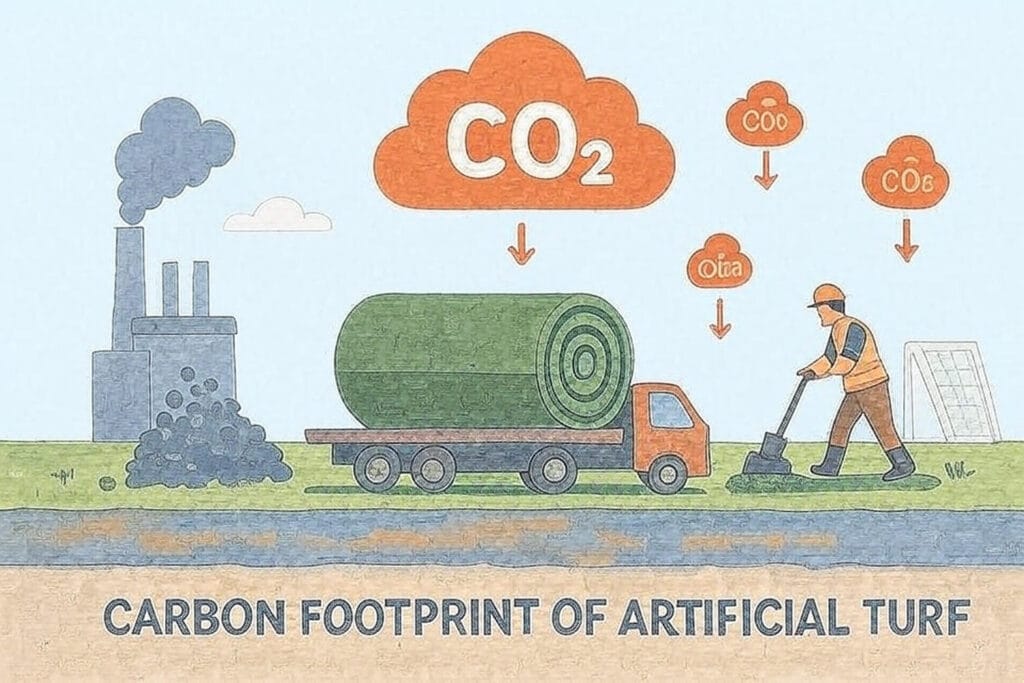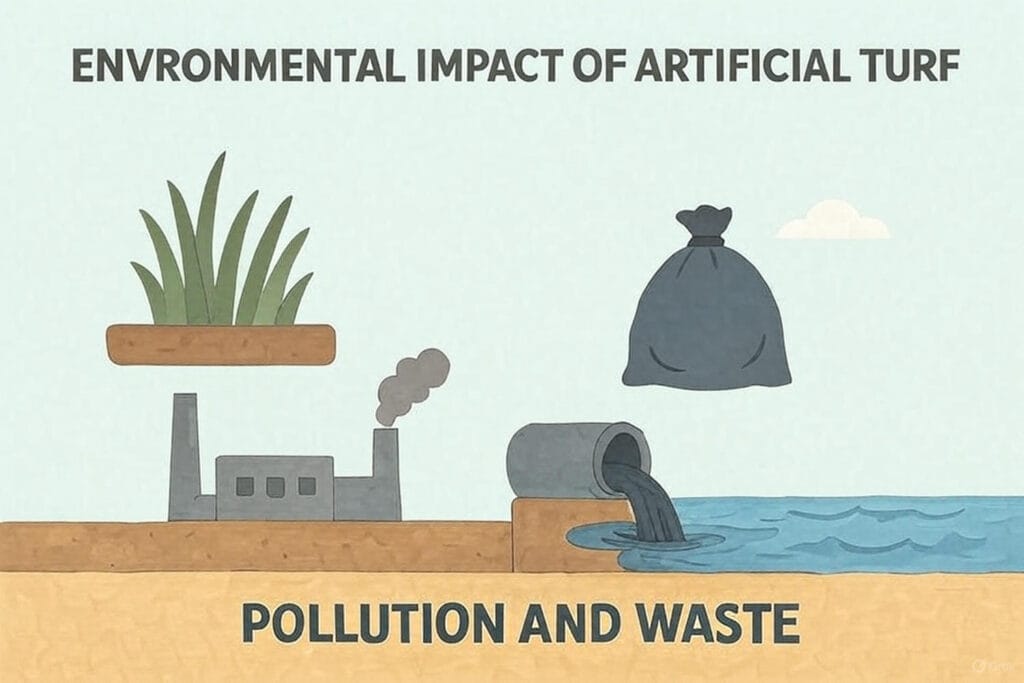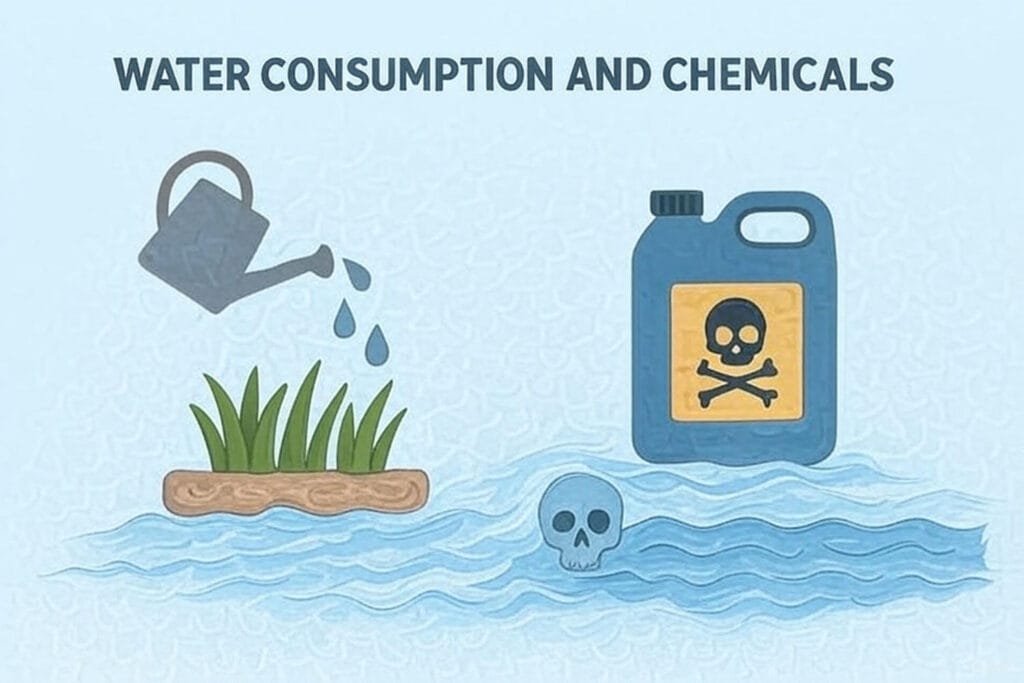
Table of Contents
ToggleWhat is Artificial Turf's and why does it matter
Artificial turf is synthetic grass or it’s a man-made surface that is designed to look like natural grass. It has become popular in cities because it requires very little maintenance. Unlike real grass, it does not need watering, mowing or fertilizers. And that’s why for many places like parks, playgrounds, sports fields and even home lawns this seems like an easy solution, especially in urban areas which are facing water shortages and limited space.
Its usability and neat appearance make it an attractive choice for city planners and homeowners. But the environmental impact of artificial turf is often overlooked. Artificial turf comes with serious drawbacks. It is produced from petroleum-based plastics, meaning fossil fuels are at the heart of its creation. This brings problems such as greenhouse gas emissions during production, heat retention in cities and end-of-life waste that is difficult to recycle.
Natural gas is capable of absorbing carbon dioxide but artificial turf cannot. They are also not capable of cooling the air or supporting biodiversity. This trade-off is even more damaging in dense urban areas with fewer natural green spaces. Nothing is free in our world, low maintenance often hides long-term costs for the environment.

How Artificial Turf production Harrm cities
The environmental impact of artificial turf begins before its installation. Turf is made from plastics such as polyethylene and polypropylene. Manufacturing these materials requires large amounts of energy which often comes from fossil fuels. This process releases greenhouse gases. Some studies have shown that a single full-sized sports field made of synthetic grass can result in hundreds of tons of CO2 emissions from production alone.
Transporting artificial turf to an urban area adds another layer of emissions. Rolls of turf are heavy and bulky which requires trucks and sometimes overseas shipping. When installation begins the soil underneath is compacted and sealed off. This destroys the natural soil ecosystem and removes the possibility of carbon storage that living plants could provide.
In crowded cities, these emissions and lost ecosystem services can make air quality and heat levels worse. Our cities are already polluted and now they are supported by the carbon footprint of synthetic turf. The result is – a chain of environmental pressure that outweighs the short-term convenience of plastic grass.
Local Climate Effects of Artificial Turf
The amount of heat trapped is one of the biggest and least talked-about environmental impacts of artificial turf. Natural grass can cool the ground through shade and water evaporation but artificial turf absorbs sunlight and radiates it back into the air. During summer days the surface of synthetic grass can reach two or three times higher temperatures than natural grass. Sometimes it becomes hotter than asphalt.
This creates serious problems in urban areas that are already struggling with the heat Island effect. When large patches of turf replace living greenery the local climate becomes warmer and hence, public spaces become uncomfortable and even unsafe. The heat surface may cause ulcers in children and athletes may face higher chances of heat-related illnesses.
The excess heat also drives up energy demand. Nearby buildings often need more air conditioning which can increase electricity use and contribute to greenhouse gas emissions. In contrast natural grass would naturally cool the surrounding area and support groundwater recharge.
Whenever we replace nature’s cooling system and replace it with plastic, we contribute to heat stress. This makes cities more vulnerable to rising global temperatures which directly conflict with long-term climate adaptation strategies. Artificial turf may look green but it makes our environment hotter and more fragile.

Waste and Recycling Challenges of Artificial Turf
You may be thinking that the story of artificial turf ends when it is installed. But this isn’t the complete truth, the environmental impact of artificial turf becomes even more concerning at the end of its lifecycle. A typical turf field lasts about 8-10 years before it needs replacement and after that ? Tons of plastic waste that is mixed with sand, rubber and heavy backing materials, must be removed.
Artificial turf is extremely difficult to recycle. It is made of multiple layers that are fused together which makes the separation process costly and labor-intensive. That’s why most of the old turf ends up in landfills where it doesn’t decompose. Over time, it breaks down into microplastics that can reach into soil and waterways.
In some cases, this turf may release toxic fumes and add more carbon emissions to the atmosphere. Cities that hoped for a green solution are forced to manage lots of waste with limited disposal options.
But if you replace an old field with a new one then the production cycle restarts which includes – transportation, CO2 emissions and future waste. On the other hand, natural grass can regenerate, support wildlife and return nutrients to the soil. The environmental impact of artificial turf grows over time.
Water Use, chemical Runoff and Maintenance Issues
Many people choose synthetic grass thinking that it will save water and reduce upkeep. Artificial turf doesn’t need regular irrigation like natural lawns but the environmental impact of artificial turf tells a different story. In hot climates, turf often requires watering just to keep surface temperatures manageable for safe use. Sports fields and playgrounds are sometimes sprayed down before activities to avoid heat-related injuries.
Another hidden cost is chemical use. Maintenance teams often apply disinfectants, herbicides and detergents to keep turf clean and odor-free. These chemicals mix with stormwater and run off into local drains, rivers and soil. The runoff may carry harmful substances including heavy metals from infill materials like crumb rubber which can pollute waterways and affect aquatic life.
Turf surfaces also accumulate dust, litter and even biological waste which require regular washing or chemical treatment. Artificial grass is a zero-maintenance option but at the same time it brings several environmental burdens. Yet, natural grass filters rainwater, supports soil health and avoids the use of synthetic chemicals in urban watersheds.

Biodiversity Loss and Ecological Trade-Offs
The most damaging environmental impact of artificial turf may be the way it replaces living ecosystems with lifeless plastic. Even in small urban patches natural grass can provide a home for insects, birds and microorganisms. These species are critical to pollination, soil health and local food chains. Cities cut off this natural network by covering soil with turf and leaving behind heat-retaining surfaces.
This loss is significant for urban biodiversity. Bees, butterflies and other pollinators lose vital feeding grounds. Soil microbes that break down organic matter and store carbon are locked out by impermeable turf layers. Even earthworms which keep soil fertile and absorb rainwater cannot survive under synthetic grass. This results in a weak ecological resilience of urban spaces.
The absence of natural vegetation also reduces opportunities for carbon sequestration and cooling which can cause the worst climate impacts in cities. In densely populated areas where every patch of green matters, if natural grass is replaced with plastic strips then natural buffers will vanish.
Artificial turf contributes to long-term biodiversity decline. According to the EPA and CDC’s Federal Research Action Plan on Recycled Tire Crumb Used in Playing Fields and Playgrounds, chemicals like PAHs, VOCs, and metals are found in artificial turf’s crumb rubber infill. The result is not just fewer plants and animals, but a weaker and less sustainable city environment for future generations.
Health concerns and alternatives of Turf
The environmental impact of artificial turf extends directly to human health. Synthetic fields often become dangerously hot with their surface temperatures recorded above 70°C (160°F) on sunny days. It is enough to cause burns and heat stress in athletes and children. The crumb rubber infill is made from recycled tires which release microplastics, heavy metals and volatile organic compounds.
Studies from Yale University have identified over 90 chemicals in tire-derived infill and some of them are linked to cancer and respiratory problems. Prolonged exposure raises long-term health concerns. Cleaning and disinfecting turf also requires chemical treatments that can linger on surfaces and wash into waterways. Artificial turf replaces safety with hidden hazards.
However, cities are beginning to rethink this approach. Some municipalities in the U.S. and Europe have restricted or banned crumb rubber infill and promoted natural grass fields that are maintained with organic practices. Other alternatives include Cork, coconut fiber or sand infill which reduce toxic exposure and heat retention.
Urban planners are also implementing native plant landscapes and pocket parks which use less water than lawns but still support biodiversity and carbon storage. Investing in natural & regenerative systems is not just safer but it also aligns with climate goals and community health. Cities can reduce pollution, protect residents and build truly sustainable green spaces.
FAQs
By what artificial turf is made?
Artificial turf is usually made from plastics like polyethylene, polypropylene or nylon. These materials are combined with a backing layer and infill (often crumb rubber or sand) to give stability and cushioning. All this makes artificial turf durable but the environmental impact of artificial turf is not negligible.
What is the environmental impact of artificial turf?
There are significant impacts of artificial turf. Its production required a large amount of energy which releases greenhouse gases. Turf traps heat, increases local temperature and also prevents soil from absorbing carbon. Over time, it breaks down into microplastics that pollute soil and water. Most of the turfs end its life in landfills.
Is artificial turf safe for children and athletes?
Artificial turf has many risks that natural grass doesn’t. The surface can reach dangerous temperatures on hot days that may cause burns. The crumb rubber infill contains chemicals that are linked to respiratory issues and skin irritation. Long-term use and frequent exposure can increase health concerns for children.
